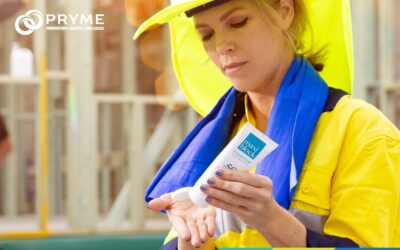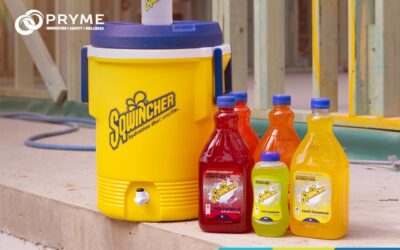Symptoms of Heat Illnesses and Heat Stress

Heat makes you lose more fluids regardless of work conditions. The loss of fluids increases when you factor in PPE, the kind of safety uniforms or clothing is worn and how hard the job is on the body. Because of these symptoms of heat illnesses and heat stress, there is a great potential for dehydration and heat stroke, heat stress and heat illnesses.
To ensure safety, all work environments should have a temperature benchmark for heat that exceeds standard precautions and considers all variables like PPE and heat released from machinery and equipment.
Just 2% of dehydration = a 20% decrease in work and mental performance
Effects of loss in fluids
Below we have summed up what will happen to your body when it loses fluids and gets dehydrated in percentages.
- 2% Loss in fluids = Impaired performance
- 4% Loss in fluids = Muscular function and capacity declines
- 6% Loss in fluids = Fatigue and exhaustion
- 8% Loss in fluids = Hallucination and disorientation
- 10% Loss in fluids = Circulatory collapse and hypothermia
It is crucial that everyone in the workforce gets to know the signs of dehydration and what to do when you or your colleagues are experiencing these signs.
With the range of safe, affordable and industry-specific hydration packs now available, no worker should ever suffer a heat-related accident or illness. It costs a lot less to prevent a heat stress illness than it does to recover from one.
Below we discuss the various types of heat illnesses as well as what to do if you or one of your colleagues are experiencing these signs.
Heat Rash
- Signs: red itchy rash appears on the face, neck, upper chest areas and groin areas.
- What to do: When possible, try to avoid sweating and make sure there is good ventilation. A cool bath or shower may help provide relief from any itching. Apply any creams or lotions that are recommended by your pharmacist. Drink plenty of fluids with electrolytes.
Heat Oedema (Swelling)
- Signs: Swelling of the lower limbs, usually the ankles
- What to do: Elevate your body parts that are swollen like your legs. Avoid heat as much as possible and stay in a cool place to cool your body temperature off. Massage your swollen body parts for better circulation of the blood to help reduce swelling. Drink plenty of fluids with electrolytes.
Heat Cramps
- Signs: Fatigue, confusion, painful muscle spasms in the arms, legs or abdominal areas.
- What to do: Stop exertion immediately, move to a cooler place and drink plenty of fluids with electrolytes. Apply firm pressure on cramping muscles, then gently massage to relieve muscle spasm. Drink plenty of fluids with electrolytes.
Heat Exhaustion
- Signs: Fatigue, confusion, clammy skin, nausea, low blood pressure, rapid pulse, fainting
- What to do: Stop exertion immediately, move to a cooler place and drink plenty of fluids with electrolytes.
Heat Stroke
- Signs: Fatigue, confusion, collapse, unconsciousness
- What to do: Stop exertion and seek medical attention immediately. Cool the body down as quickly as possible to reduce body temperature with cold baths, sponging, fans, and/or air conditioners. It is important to not give fluids and wait for medical assistance to arrive. A body temperature of 40°C or higher during a heat stroke can be fatal.
As temperatures soar in unpredictable climates, working outside can cause overexposure to the sun, leading to heat stress and dehydration. Workers across Australia and New Zealand are asking themselves what to wear when working outside in the heat.
According to Safework Australia, working in extreme heat can lead to a range of heat-related illnesses, including heat rash, heat exhaustion, and heatstroke. It’s essential to know the signs of heat stress and take measures to prevent it.
Maintaining proper hydration and managing heat-related risks in the workplace are crucial for the well-being and safety of workers. By understanding the potential effects of fluid loss and dehydration, as well as recognising the signs of heat illnesses, individuals can take proactive measures to prevent such conditions. Utilizing effective solutions like Sqwincher for hydration and electrolyte replenishment, along with Ergodyne’s Cooling PPE, can significantly mitigate the risks associated with heat stress. Moreover, promoting awareness and education about heat-related illnesses and appropriate response measures is essential for creating a safe work environment. By prioritizing preventive measures, employers can ensure the health, productivity, and overall well-being of their workforce, while also reducing the financial and human costs associated with heat-related accidents and illnesses. Remember, staying hydrated and cool is not just a matter of comfort but a crucial aspect of workplace safety.
RELATED: Humidity & Heat Stress Management
REFERENCE: https://www.safeworkaustralia.gov.au/safety-topic/hazards/working-heat/checklist-managing-risks-heat-workplace
Categories
Recent Posts
- Innovation in Knee Protection: The Proflex® Hinged Knee Pads
- Celebrate Australian Made Week 2024 with Maxiblock Sunscreen
- MATES BIG LAP 2024: Get moving for your mates
- Understanding Heat Stress Risks for Outdoor Workers in the Tropics
- How Australian Businesses Can Prepare for Extreme Heat Events: Insights from KPMG’s Heat Report
Brands
- Ergodyne
- Sqwincher
Sqwincher is an electrolyte enhanced beverage for effective hydration and is the recognised leader in providing hydration solutions to hot workplaces, to help reduce heat related illness and accidents. Keep your workers safe and productive with Sqwincher hydration that works.
- Maxiblock Sunscreen






